U.S. Air Force Vietnam War Griffith, IN Flight date: 09/25/24
By Al Konieczka, Honor Flight Chicago Veteran Interview Volunteer
Bernadette “Bernie” Sanner always dreamed of being a nurse from the time she was a little girl growing up in East Chicago, Indiana. “I had a grandmother named Sophie who came here from Poland. I remember always talking with her about being a nurse. She even set up an annuity for me when I was a child, which I never knew about. By the time I got older, the money for me to go to nursing school was already there thanks to my grandma.”
After high school, Bernie attended nursing school and was the last class to take the three year program offered at St. Margaret Hospital in Hammond, IN. In fact, her training at St. Margaret’s was instrumental in her decision to go to Vietnam. “I idolized my head nurse Margaret Carello. She’d been a World War II nurse. I was there with her the day they told her that her son was MIA and they found his body the next day. There were a lot of things like that that happened while you were there that really became a part of you.”
During her third year in the nursing program, it seemed like every branch of the military tried to recruit her. As Bernie recalled, “They took us on little outings for the day and even offered to pay for our education if we would enlist. They really wanted nurses.”
Bernie’s Aunt Helen was the person who originally got her interested in the Air Force. Bernie was recruited at the age of 22 and her basic training was very brief, perhaps two or three weeks where she learned how to be an officer. Bernie recalled, “Our training was in San Antonio and I actually went to Dyess Air Force Base, which was in Abilene, Texas which was maybe 100 miles away. So I was in Texas that whole first year I served.”
After Texas, Bernie suddenly found herself on an airplane headed for Vietnam. She left Seattle, Washington on July 1, 1968 and arrived three days later at Cam Ranh Bay. The Air Force assigned the first female nurses to Vietnam in February of 1966, many to Cam Ranh Bay. Female flight nurses began flying aeromedical evacuation missions over Vietnam in 1967, providing care to wounded service members during transport. “In the units we were assigned to in Vietnam, we only saw doctors a few days a week. They just told us what to do and we did it. We worked on our own because the doctors were in the operating room most of the time. Most of the work we did was to prepare the wounded soldiers to be air evacuated out.”
The base at Cam Ranh Bay was huge and had units from all different branches of the military. While mortar attacks only occurred every few months, the Army area of the camp got hit most often. The hospital was located near the flight area so the medical staff had access to the transport planes. The nurses worked in shifts. “We did 12 hours shifts. We did that for seven days and then you had a day off to flip. So we worked 7am to 7pm and then had a day off and then flipped to work 7pm to 7am the next seven days.”
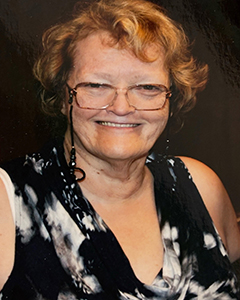
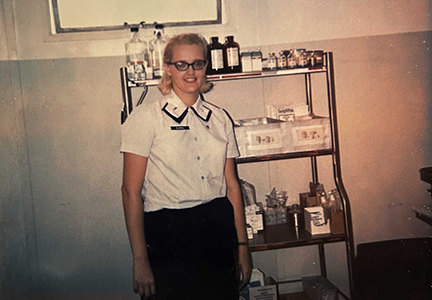
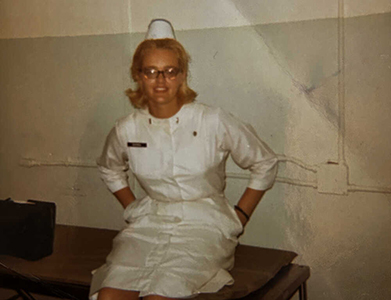

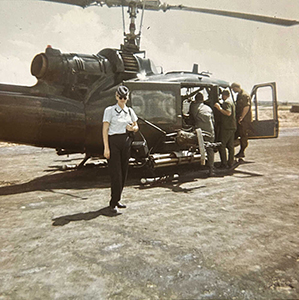
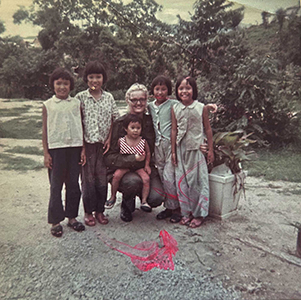
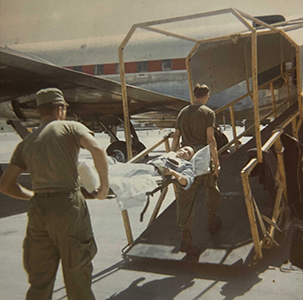
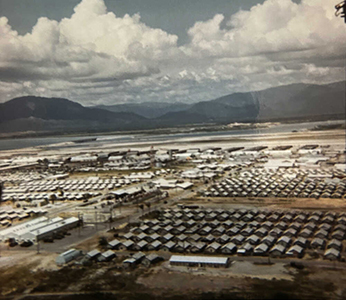
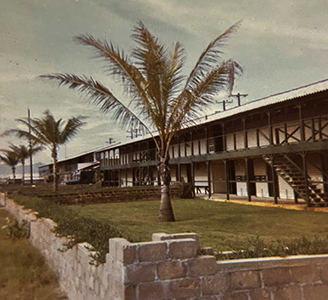
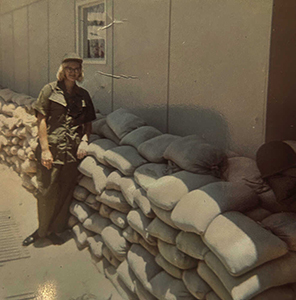
Bernie’s unit was an orthopedic unit so they saw many casualties due to the number of amputations and injuries from punji sticks. The punji stick is a type of booby trapped stake. It is a simple spike, made out of wood or bamboo, which is sharpened, heated, and usually set in a hole. Punji sticks would be placed in areas likely to be passed through by enemy troops. Sometimes punji sticks were coated in poison or even human feces causing severe infection or poisoning in the victim.
The casualties would arrive at the base by chopper directly from the battlefield. Medics at the base would perform triage, the doctors would perform the necessary surgeries and the nurses would then provide the blood and antibiotics required to stabilize them until the doctors released them for transport. “In each unit on average we saw 90 patients per day and maybe 10 of those would be released to be air lifted out. Those with punji stick injuries typically stayed longer while those with amputations were sent out rather quickly. There were patients who stayed in the hospital for weeks with horrible infections and required lots of antibiotics before they were stable enough to be transported.”
The nurses in Bernie’s unit all worked together very closely wherever they were needed. The nurses organized and distributed all of the medications, performed all of the intravenous treatments, assembled special beds for the spinal cord victims and coordinated with the air-evac teams. They did whatever they could for their patients to make them more comfortable.
Bernie was actually married during her tour in Vietnam. On her seven day R&R break, she flew to Hawaii to get married. “I arrived in Vietnam in July and got married in January. I met my husband Robert during training in Abilene and while he also served as a medic in the Air Force, he stayed stateside and never went to Vietnam.”
When asked about the weather in Vietnam, Bernie summed it up in five words. “The weather was God awful. I don’t ever remember seeing clouds but it seemed like it always rained. It wouldn’t rain all day, but when it ended, it was so humid. Each area in the hospital had an air conditioner but it only worked 60% of the time because it was running constantly.”
The Air Force also experimented with different uniforms for the nurses to see if they could tolerate the heat better. “We wore uniforms sometimes. It was kind of a joke. Sometimes you wore fatigues and sometimes you wore a uniform. The blue and white outfits were considered our fatigues and that’s what we wore 99% of the time. Every so often they had us try working in a new uniform made with different material.”
There are two memories from Vietnam that Bernie said she carries to bed with her every night – more than half a century later. “One was when I was working in the air-evac unit where all you do is basically keep the patient stable and comfortable until they get on a plane. There was this really big guy and he had no arms or legs and he kept asking me to kill him. He didn’t want his mom to see him that way. Of course I couldn’t do that. He ended up dying that night and I was glad that God took him. The other was a time when the ER was too full of casualties so we had soldiers that came to us directly from the battle field. One of the guys that came in was holding his own hand which had been blown off. He kept screaming at me to sew it back on. His arm was all gone and he was just holding onto his hand. When he came out of surgery all he did was yell at me because I didn’t sew his hand back on. But there was nothing left to sew back on. Those memories are the two guys I fall asleep with every night.”
Upon her return to the states, Bernie worked as a nurse in Houston where her husband was located. A year later they moved back to NW Indiana and Bernie worked at St. Catherine’s Hospital and then went back to St. Margaret’s Hospital after she had her children. For the last 20 years of her career she worked in long term care and even trained many nurses.
After Bernie’s tour in the Air Force was finished, all the nurses simply went their separate ways. However, a few short years after the dedication of the Vietnam Veterans Memorial wall in 1982 a group of women, led by Diane Carlson Evans, RN, decided it was time to honor the heroism of American women who served in Vietnam. In 1984 the Vietnam Women’s Memorial Project began as a way to give those women veterans a voice by highlighting their stories and educating the public.
As the project began to move forward, Bernie met with other nurses twice a year in Springfield, Illinois. “There was a group of us nurses who all got together to talk about the things we had experienced in Vietnam and how it affected us. The local VFW and American Legion took really good care of us. They got us all hotel rooms and provided our food while we were in town for meetings.”
Bernie was a speaker on September 12, 1993 as the Vietnam Women’s Memorial was travelling through Indiana on its way to Washington DC. She has given many speeches since then as well to educate people on the women who served in Vietnam. “You always deal with death and dying as a nurse but as a nurse in Vietnam, it was totally different. You became truly more religious than ever before. And from a skills perspective, your skill level was a million times higher than any other nurse who hadn’t served in a war.”
Bernie has two children of her own, a son and a daughter and five grandchildren. In addition, Bernie has two step-children and has been blessed with seven grandchildren and six great-grandchildren through those step-children. Bernie loves her entire family very much and they’re all a huge part of her life.
Bernadette, thank you very much for your dedicated service and the many soldiers you treated. Enjoy your well-deserved trip to Washington D.C.!


